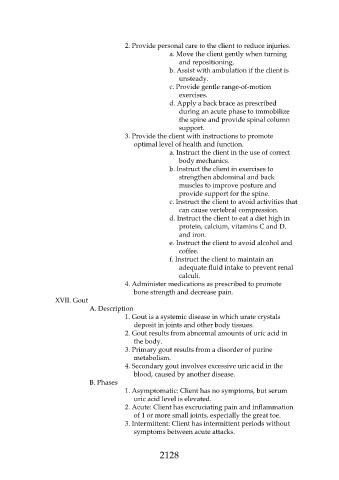Page 2128 - Saunders Comprehensive Review For NCLEX-RN
P. 2128
2. Provide personal care to the client to reduce injuries.
a. Move the client gently when turning
and repositioning.
b. Assist with ambulation if the client is
unsteady.
c. Provide gentle range-of-motion
exercises.
d. Apply a back brace as prescribed
during an acute phase to immobilize
the spine and provide spinal column
support.
3. Provide the client with instructions to promote
optimal level of health and function.
a. Instruct the client in the use of correct
body mechanics.
b. Instruct the client in exercises to
strengthen abdominal and back
muscles to improve posture and
provide support for the spine.
c. Instruct the client to avoid activities that
can cause vertebral compression.
d. Instruct the client to eat a diet high in
protein, calcium, vitamins C and D,
and iron.
e. Instruct the client to avoid alcohol and
coffee.
f. Instruct the client to maintain an
adequate fluid intake to prevent renal
calculi.
4. Administer medications as prescribed to promote
bone strength and decrease pain.
XVII. Gout
A. Description
1. Gout is a systemic disease in which urate crystals
deposit in joints and other body tissues.
2. Gout results from abnormal amounts of uric acid in
the body.
3. Primary gout results from a disorder of purine
metabolism.
4. Secondary gout involves excessive uric acid in the
blood, caused by another disease.
B. Phases
1. Asymptomatic: Client has no symptoms, but serum
uric acid level is elevated.
2. Acute: Client has excruciating pain and inflammation
of 1 or more small joints, especially the great toe.
3. Intermittent: Client has intermittent periods without
symptoms between acute attacks.
2128

